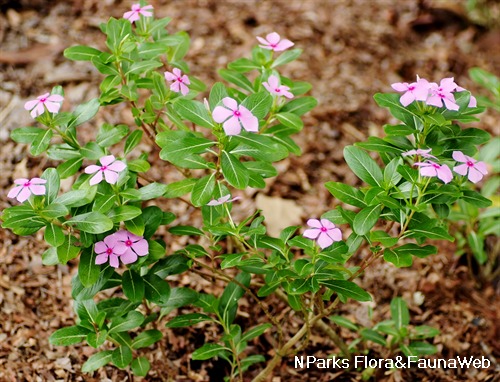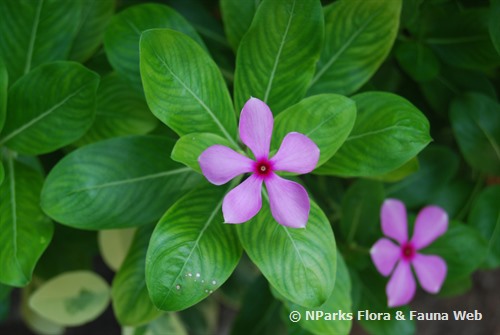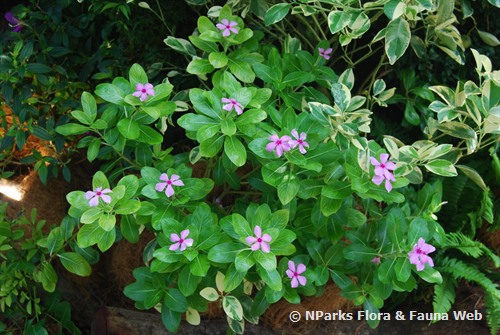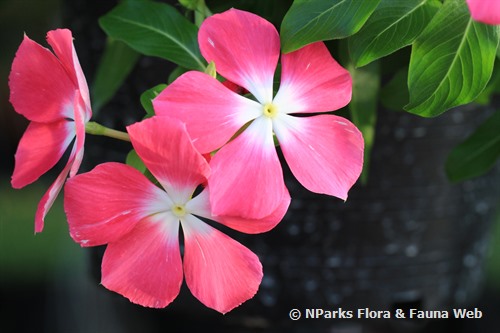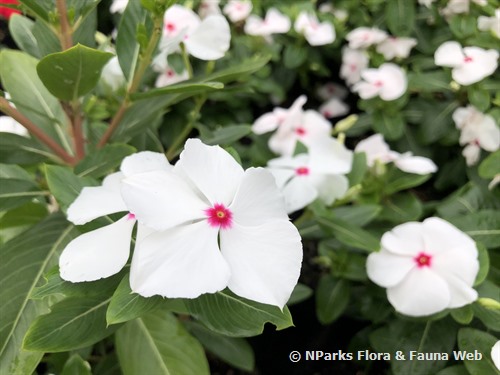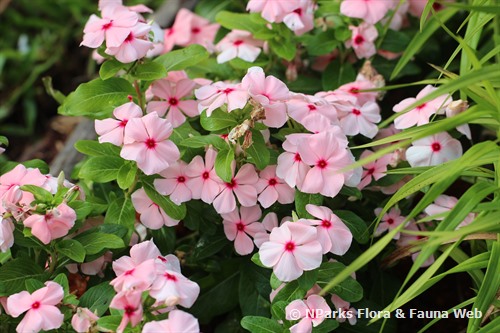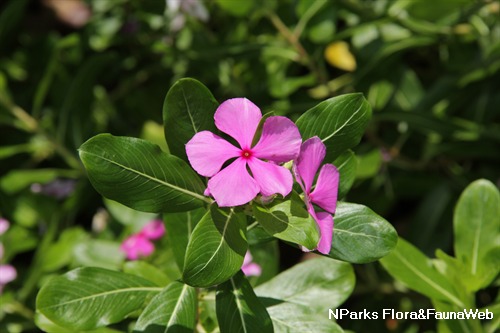
Back
Catharanthus roseus (L.) G.Don
| Family Name: | Apocynaceae |
| Synonyms: | Vinca rosea, Acokanthera rosea, Lochnera rosea |
| Common Name: | Madagascar Periwinkle, Old Maid, Cayenne Jasmine, Rose Periwinkle, West Indian Periwinkle, Periwrinkle, Tahi Ayam, 日日春, 长春花 |
Name
Classifications and Characteristics
| Plant Division | Angiosperms (Flowering Seed Plants) (Dicotyledon) |
|---|---|
| Plant Growth Form | Shrub |
| Lifespan (in Singapore) | Perennial, Semi-Annual / Annual-Like |
| Mode of Nutrition | Autotrophic |
| Maximum Height | 0.3 m to 1 m |
| Maximum Plant Spread / Crown Width | 0.3 m |
Biogeography
| Native Distribution | Madagascar |
|---|---|
| Native Habitat | Terrestrial |
| Local Conservation Status | Non-native (Spontaneous (Naturalised)) |
Description and Ethnobotany
| Growth Form | Semi-woody shrub, short-lived perennial which is sometimes grown as annual, able to grow up to 0.5 - 0.8 m tall. |
|---|---|
| Foliage | Leaves glossy dark green, oval in shape, opposite arrangement, measuring about 2.5 - 3.5 cm long. |
| Stems | Bruised or cut stems secrete milky-white sap. |
| Flowers | Tubular flowers red to light pink, with 5 flattened petal-like lobes. |
| Fruit | Fruits are explosive follicles. |
| Others - Plant Morphology | Suitable for landscaping flower borders or grown in containers. Prefers poor, well-drained soils. Relatively drought-tolerant when established, and overwatering may cause root rot. Plant may not flower well in overly-fertile soils. Remove dead flowers to encourage continued blooming. |
| Etymology | Genus Catharanthus is from the Greek word "katharos" which means "pure (perfect) flower". Species roseus means "rose-like" |
| Ethnobotanical Uses | Food (Herb or Spice) Medicinal: Plant is rich alkaloids used in treatment of diseases. Used as remedy against diabetes, high blood pressure, asthma and menstrual disorders. Modern medical research has shown that extracts of the plant can be used in anti-cancer drugs to treat leukemia and Hogkins' Disease. |
Landscaping Features
| Desirable Plant Features | Ornamental Flowers |
|---|---|
| Landscape Uses | Container Planting, Coastal, Suitable for Hanging Baskets, General, Flowerbed / Border |
| Thematic Landscaping | Naturalistic Garden |
| Usage Hazard - Cons Remarks | Alkaloids in the plant may cause hallucination when taken at high doses. |
Fauna, Pollination and Dispersal
| Fauna Pollination Dispersal Associated Fauna | Moth Food Plant, Butterfly-Attracting |
|---|---|
| Seed or Spore Dispersal | Abiotic (Explosive Dehiscence) |
Plant Care and Propagation
| Light Preference | Full Sun |
|---|---|
| Water Preference | Moderate Water |
| Rootzone Tolerance | Well-Drained Soils, Poor Infertile Soils, Drought Tolerant |
| Maintenance Requirements | Low |
| Propagation Method | Seed, Stem Cutting |
| Planting Distance | 0 |
Foliar
| Mature Foliage Colour(s) | Green |
|---|---|
| Mature Foliage Texture(s) | Glossy / Shiny |
| Foliar Type | Simple / Unifoliate |
| Foliar Shape(s) | Non-Palm Foliage (Elliptical) |
| Foliar Venation | Pinnate / Net |
| Foliar Margin | Entire |
| Foliar Apex - Tip | Rounded |
| Typical Foliar Area | Notophyll ( 20.25cm2 - 45 cm2 ) |
| Leaf Area Index (LAI) for Green Plot Ratio | 4.5 (Shrub & Groundcover - Dicot) |
Non - Foliar and Storage
| Stem Type & Modification | Herbaceous |
|---|
Floral (Angiosperm)
| Flower & Plant Sexuality | Bisexual Flowers |
| Flower Colour(s) | Pink |
|---|---|
| Flowering Habit | Polycarpic |
Fruit, Seed and Spore
| Mature Fruit Colour(s) | Green |
|---|---|
| Fruit Type | Dehiscent Dry Fruit , Follicle |
Image Repository
Others
| Master ID | 495 |
|---|---|
| Species ID | 1791 |
| Flora Disclaimer | The information in this website has been compiled from reliable sources, such as reference works on medicinal plants. It is not a substitute for medical advice or treatment and NParks does not purport to provide any medical advice. Readers should always consult his/her physician before using or consuming a plant for medicinal purposes. |

